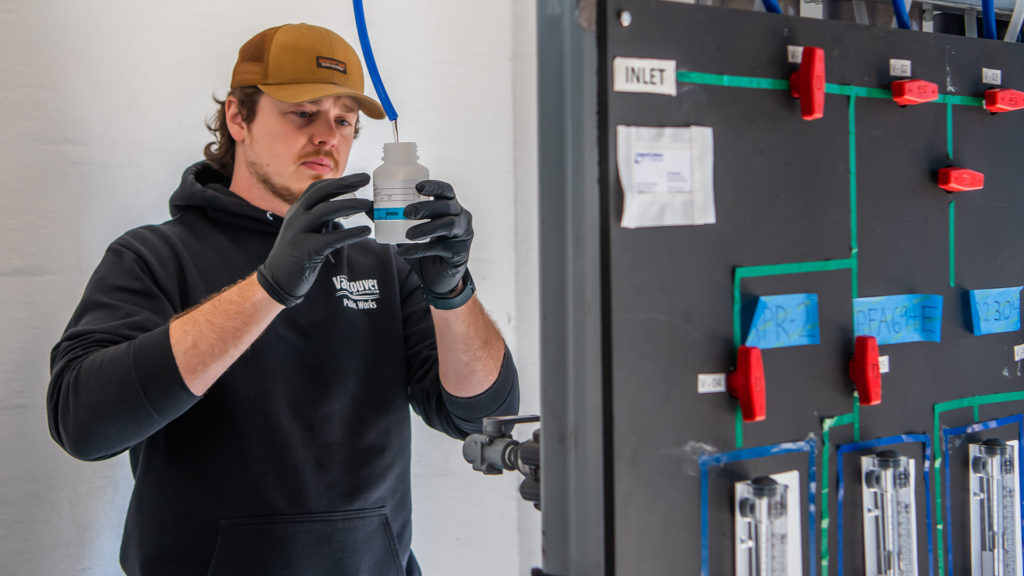PFAS Sampling Results
The City of Vancouver provides information about PFAS sampling results to enable drinking water customers to stay informed. Visit Learn about PFAS for more information about actions the City is taking to keep your water safe and for steps you can take at home.
U.S. Environmental Protection Agency Final National Primary Drinking Water Regulation and PFAS Maximum Contaminant Level
In April 2024, the U.S. Environmental Protection Agency announced the final National Primary Drinking Water Regulation (NPDWR) for six PFAS. This establishes legally enforceable levels, called Maximum Contaminant Levels (MCLs), for six PFAS in drinking water. Public water systems must monitor for these PFAS and provide information to community members. Public water systems will have five years (by 2029) to implement solutions to reduce these PFAS if monitoring shows that drinking water levels exceed the MCLs. Beginning 2029, public water systems that have PFAS in drinking water exceeding the established MCLs must take action to reduce levels of PFAS in their drinking water. Federal regulations set by the EPA supersede Washington State Action Levels.
Washington State Board of Health PFAS State Action Levels
In 2021, the Washington State Board of Health adopted State Action Levels for five PFAS that set testing and notification requirements for some water providers, including Vancouver starting in 2023. State Action Levels are set to protect human health and based on the best available science at the time. PFAS chemicals are still being researched and health advice is updated as new science becomes available. State Action Levels are public health goals to protect all people, including sensitive groups and life stages, from potential harmful effects of drinking water with PFAS over a lifetime.
If you have been drinking water over the State Action Level, it doesn’t mean you will get sick or have health problems from this exposure. Learn more at doh.wa.gov/pfas.
PFAS Finalized Federal Maximum Contaminant Levels / State Action Levels
| Types of PFAS | EPA Maximum Contaminant Level (Enforcable, Requires treatment by 2029) | Washington Department of Health State Action Level (Superseded) |
|---|---|---|
| PFOA | 4 ppt | 10 ppt |
| PFOS | 4 ppt | 15 ppt |
| PFNA | 10 ppt | 9 ppt |
| PFHxS | 10 ppt | 65 ppt |
| HFPO-DA (commonly referred to as GenX Chemicals2) | 10 ppt | – |
| Mixtures containing two or more of PFHxS, PFNA, HFPO-DA and PFBS | Hazard index of 1* | PFBS, 345 ppt |
11 ppt (part per trillion) is equivalent to a single drop of water in 20 Olympic-sized swimming pools
2GenX chemicals are not on the Washington State Department of Health’s list of PFAS with State Action Levels
3EPA intends to provide water systems with a web-based form that will automatically calculate the Hazard Index for four types of PFAS together
*The hazard index of 1 is the level at which no known health risk could be anticipated
City of Vancouver PFAS Test Results
Sampling Dates Shown Here: February 2025
Below are the sampling results from the City’s water stations. Vancouver has an open system in which water can be transferred from almost any water station to different areas of the City. We are adjusting our operations and prioritizing use of sources with lower levels of PFAS. However, due to the prevalence of PFAS in local groundwater, water rights limitations and operational restrictions, we are unable to turn off all PFAS sources that exceed MCLs without impacting supply.
Note: ND = non detect; ppt = parts per trillion (1 ppt is equivalent to a single drop of water in 20 Olympic-sized swimming pools)
Most Recent PFOA Sampling Results: February 2025
Results above MCLs are shown in bold below.
| City of Vancouver Water Station | PFOA Results (ppt) | PFOS Results (ppt) | PFBS Results (ppt) | PFHxS Results (ppt) | PFNA Results (ppt) | HFPO-DA Results (ppt) |
|---|---|---|---|---|---|---|
| Water Station 1 | 2.5 | 4.9 | 4.4 | 5.4 | ND | ND |
| Water Station 3 | 2.7 | 5.2 | 4.8 | 5.0 | ND | ND |
| Water Station 4 | 6.0 | 17 | 4.9 | 5.9 | ND | ND |
| Water Station 7 | ND | 4.5 | 2.4 | 4.0 | ND | ND |
| Water Station 8 | 4.4 | 9.2 | 5.0 | 4.6 | ND | ND |
| Water Station 9 | 5.4 | 11 | 6.1 | 3.1 | ND | ND |
| Water Station 14 | 8.8 | 17 | 8.8 | 4.6 | ND | ND |
| Water Station 15 | 5.2 | 12 | 6.0 | 5.2 | ND | ND |
| Ellsworth | ND | ND | ND | ND | ND | ND |


